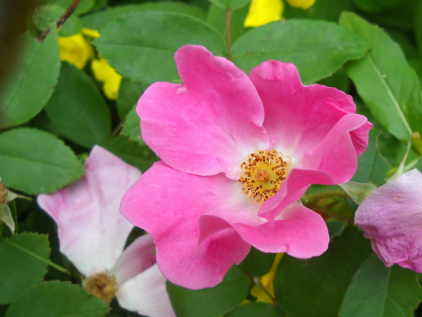
tel. 512 280 1192 June 21, 2018
Nursery notes: Happy Solstice! So nice to have some rains this
week to ease our plants and us through the summer months. All
of the plants are looking splendid this week ; - ) We have lots of
roses in stock: 3 gal. white, red Knock-Outs, Nearly Wild, Bel-
inda's Dream, Martha Gonzalez and Drift Roses: 3 gal for $26.
Also cardamom, tumeric and galangal, 1 gal for $13, and limit-
ed supplies of Duke of Tuscany and Maid of Orleans jasmines.
Please drop by for a visit.❦

Amanda Moon writes: As our time together comes to a close at
It’s About Thyme, I would like to personally offer my thanks to
every one of you who has shopped and learned from us over the
years. I have gotten to know so many of you in my 20 plus years
'hanging' around the nursery, first as an employee fresh out of high
school, then as a landscape designer and more recently as one of
the newsletter and KLRU Central Texas Gardener contributors.
My first rosebush, Rosebud, came from It’s About Thyme - a gift
from my future husband while we were still in high school! Diane
did our wedding flowers 24 years ago July. What a ride from those
beginnings!
It has been a joy to get to grow in my own knowledge of the plant
world through It’s About Thyme and through the many wonderful
questions I have had a chance to answer over the last two decades.
I remember when I first started at the nursery (aging myself now!),
I carried garden books around under my arms, ready to look up any
question asked.
As I move on with my next chapter (working with Site One Land-
scapes in Pflugerville), I will continue to write and am in the pro-
cess of restarting two blogs I have been working on. Thanks again
for the many years of hard work and fun! I will miss all of you!
(She chokes up as she signs off...) ❦
____________________________________________________
Spanish white garlic soup: for those of you who have already
consumed a few gallons of gazpacho this year, you might enjoy
making this delicious (and simple) summer soup for a change -
with almonds, bread, olive oil and garlic. Sopa de Ajo Blanco ❦
____________________________________________________
Central Texas Gardener: a visit to the gardens of Ashley Romero
and Juan de los Rios, and a chat with graphic designer James Barela
about his Baetanical how-to blog. See the show on Saturday 4 p.m.
Sunday 9 a.m. or click here: KLRU ❦

by Amanda Moon
Roses can be a beautiful, easily-grown addition to any yard that
has lots of sun and room for them to grow. (To thrive they need
a minimum of 6-8 hours sunshine.)
But within the rose family there are different groups and classes,
and if you understand these, you’ll have a better understanding
of which roses will work best in your yard, and which ones will
give you the shape, color or fragrance that you are looking for.
Roses are divided into three main groups: antiques, old garden,
and modern. The groups are then divided into classes. These give
us an idea of how a rose will grow, bloom and thrive in a partic-
ular area. Some classes, for example, do best with a heavy pruning
every year, and others are better left alone.
____________________________________________________
1. Antique Roses: This class contains roses that were introduced
before 1867, when the first hybrid tea rose, La France, was introdu-
ced. In some cases many of these roses have been grown some-
where on this planet for more than 1000 years. So you could say
those still in production are the ultimate tried and true.
Tea roses are the predecessors of our modern hybrid teas. They
typically have larger blooms full of petals with a high center comm-
on with florist roses. The buds are smaller than hybrid teas and
the stems shorter, but most tea roses have a wonderful light frag-
rance. The bushes tend to be large and round and they bloom heav-
ily in the spring and fall.
China roses are one of my favorite rose classes. They are sturdy
and can bloom nine months out of the year. Generally large shrubs
(with some climbers) they are hardy and drought resistant. This
is one of the classes found on abandoned homesteads throughout
the state.
The best thing about bourbon roses is their amazing, heady frag-
rance. Bourbons can be large shrubs, climbers or smaller more
manageable bushes.
Polyantha roses are smaller bushes, with smaller flowers borne in
clusters at the end of the branches. They bloom profusely and are
very easy to take care of.
_____________________________________________________
2. Old Garden Roses: Though not technically antiques, these roses
have been around long enough to have proven their mettle in our
tough climate.
Hybrid Musk roses really hit their stride starting in the 1920s. They
are large shrubs that can also be trained as small climbers and can
take five hours of sun a day and still bloom well. They have a nice
musky fragrance and bloom in clusters. My family has several musk
roses that have been passed down for more than 60 years.
Older Hybrid Teas have been around so long that they are now
grouped in with the other antiques and old fashioned roses. They
tend to have longer stems and higher centers than the tea roses.
Some of their blooms, like Peace, can be quite large and showy.
They also have more of an upright, slender growth habit than their
predecessors.
______________________________________________________
3. Modern Roses: This is the ‘everything else’ group. These roses
are more recently developed than the previous group, but still contain
some great rose varieties. It is with the modern roses that we start to
see the huge full flowers that florists crave and the vibrant colors not
seen in antique and older roses. Oranges and bright yellows especially
make their mark with the newer introductions.
Shrub roses were never meant to be classified. They were develop-
ed to grow and behave like blooming shrubs. Knock Out roses are
probably the best examples of this class. They are for the most part
disease resistant, fast growing and heavy blooming.
Hybrid Teas and Grandifloras are two classes of roses developed for
their flowers. They have large, full, bright flowers on long stems . . .
perfect for floral arranging. They can require a little more care than
other classes and need yearly hard pruning, but they can’t be beat for
their blooms.
Floribunda roses are best thought of as the original shrub roses. These
are smaller bushes (under 4’ typically) with lots of blooms. They
usually perform very well with little oversight and don’t need much
pruning except to keep their shape.
Here are some of the beautiful roses that we are carrying at the
nursery at present: red and white Knock-Outs, double red Knock-
Outs, Belinda's Dream, Nearly Wild (photo above), drift roses,
Julia Child, red cascade (climbing), Martha Gonzalez and Ducher.
Last but not least an amazing tale of survival known as Peggy Mar-
tin. This rose was discovered after Katrina had ravaged its home-
site, where she had sat for weeks under brackish water only to come
out alive on the other side. This thorn-less, climbing rose has gain-
ed traction over the last 12 seasons because of this resilience and is
a fine addition to any landscape. Happy rose gardening everyone!


